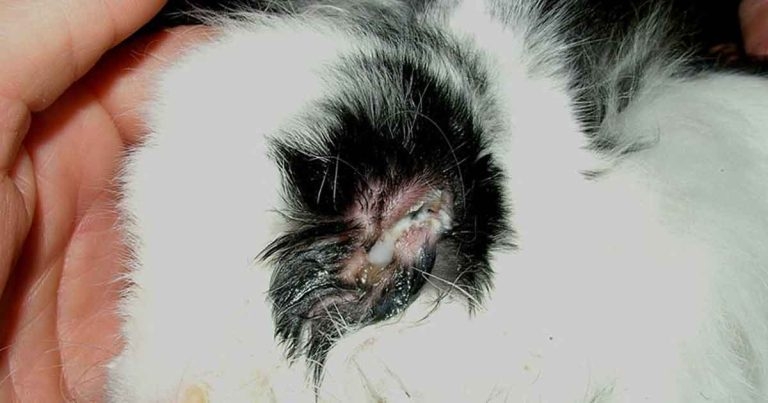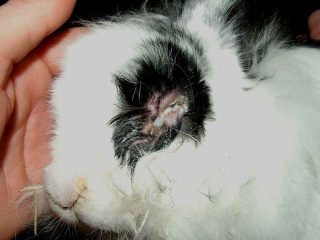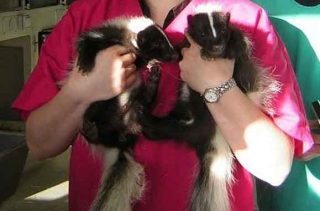28 Nov 2016
Marie Kubiak explores vaccine options and precautions to be taken in various species, as well as complications caused by viral haemorrhagic disease type two in UK rabbits.

Figure 1. Myxomatosis is preventable by vaccination; however, many pet rabbits remain unvaccinated. Clinical disease in unvaccinated rabbits typically presents with ocular, nasal and genital swelling, mucopurulent ocular discharge, respiratory compromise, and has extremely high mortality. Image: © Sergio Silvetti.
Vaccination can be key in preventing clinical disease, but few licensed vaccinations are available for non-traditional companion mammals. This article considers the key diseases that can be managed with vaccination for more common mammals that may present to general practitioners.
Although licensed vaccines are lacking in the majority of exotic pet species (with exceptions of the combined rabbit myxomatosis and calicivirus vaccine, and two ferret rabies vaccines), it may be prudent to use off-licence vaccination of individuals to prevent disease.

Many vaccines have been used off licence in exotic pets for many years and adverse responses are rare, but objective data for use of vaccines across the wide range of species seen in practice is lacking, so caution must still be exercised, particularly in more unusual exotic mammals.
As a precaution, the author keeps all exotic animals being vaccinated with an off-licence vaccination on the premises for 20 minutes post-vaccination, in case of adverse response. As yet, no reactions have been seen with a large caseload of a wide variety of species, but the protocol remains in place as a precaution.
Myxomatosis is a familiar disease to most clinicians. This familiarity is partially due to its widespread nature, but also due to the chronic course of disease and clearly evident signs resulting in identification of disease, and resulting presentation of animals (both pet and wildlife) to vets in many cases (Figure 1).
Viral haemorrhagic disease (VHD) – also known as rabbit haemorrhagic disease – is caused by a calicivirus and is not diagnosed as frequently. It appears to be less common as a clinical syndrome, but the rapid progression and lack of external signs often result in acute death with no opportunity to present animals to the vet for assessment, limiting recognition of the disease. As such, it is likely underdiagnosed and true prevalence not well understood.
Rabbits are fortunate enough to have licensed vaccines available for both major diseases endemic to the UK, myxomatosis and VHD type one (VHD1). Both diseases are invariably fatal in unvaccinated rabbits, so preventive vaccination is strongly recommended. Even house rabbits are not safe if unvaccinated as both diseases can be transferred by biting insects (including mosquitoes and fleas) and VHD virus can be carried into houses on fomites, such as shoes and clothing.
A combined vaccine is available protecting against both myxomatosis and VHD1. Rabbits can be vaccinated from five weeks of age with a single vaccination and annual boosters. This has superseded the previous separate vaccines for VHD1 and myxomatosis that necessitated three vaccines per year – the separate vaccines are no longer available.
Vaccination is very effective in preventing disease, but if vaccinated rabbits are naturally infected with large quantities of myxomatosis virus, they can still develop a mild form of the disease with skin nodules developing, but this is usually self-limiting and non-fatal. Caution should be exercised in vaccinating breeding bucks as, although no known problems have been identified, no evaluation of potential effects on fertility has occurred.
The introduction of VHD type two (VHD2), a strain of rabbit calicivirus not previously seen in the UK, has complicated VHD vaccination. Disease progression appears slower and less aggressive than VHD1, with lower, but still significant, mortality seen. Strong suspicion exists VHD2 will establish within the wild population in the UK, and become endemic and a significant threat to wild and pet rabbits. As such, vaccination against this variant should be considered.
The UK combined vaccination does not protect against VHD2 and a Special Import Certificate (SIC) or Special Treatment Certificate has been necessary to source protective vaccination from Europe. These vaccines are Filavac VHD K C+V (Filavie, France), Cunivak RHD (IDT Biologika; GmbH and Co, Germany), Novarvilap (Ovejero, Spain) and Cunipravac RHD2 Variant (Hipra, Spain) and are designed for use in farmed rabbits, with little data on use in pet rabbits.
Filavac is most commonly used for pet rabbits due to availability, with the option to order it through UK wholesalers following receipt of a SIC and the option for purchasing single-dose vials for cost-effective vaccination of small numbers of animals. Manufacturer guidelines for Filavac advise a single starter vaccination, followed by annual boosters, but breeding does considered at high risk should be vaccinated every six months. As these vaccines are not licensed in the UK, they are being used off licence with the attendant precautions to be discussed with owners prior to vaccination.
A registered version of Cunipravac has been authorised for use across the EU for protection against VHD2, renamed as Eravac (Hipra, Spain), but this vaccination is targeted at farmed rabbits for human consumption, with no data available on use in pet rabbits. As such, long-term effects and booster interval are unknown.
Additional concerns include pain and tissue necrosis on self-injection, and more than 10% of animals developing post-vaccination complications – primarily a transient pyrexia. The VMD advises import of Filavac and other unauthorised vaccines can occur under the cascade if, based on professional judgement, the authorised vaccine is not appropriate for a particular situation or patient, or if Eravac is not available. It is unclear if the situation of pet rabbits requiring ongoing immunity is sufficient clinical justification for continuing to use imported, unauthorised vaccinations with superior supporting data on duration of immunity and repeated vaccination in pet rabbits.
The disease is still current, with outbreaks in the West Midlands affecting dogs, skunks and ferrets, resulting in the death of large numbers of infected animals. Clinical signs mirror those seen in domestic dogs (Figure 2). Prevention with vaccination is simple and vaccines are readily available.
No single distemper vaccine exists, all available vaccines are produced for domestic dogs and combine distemper components with other vaccines.
A small number of canine vaccines have been produced using viruses grown in ferret cell cultures. These are not recommended for use in ferrets, skunks or other exotics, as there is a small potential for the virus to revert to virulence and cause disease.
Attenuated live vaccines produced in chick cell lines are appropriate, but inactivated vaccines do not provide adequate protection. If vets are unsure whether the vaccine they use for domestic pets is also safe for other species, a telephone call to the vaccine manufacturer is the best way to confirm whether the vaccine can be used.
In the US, a monovalent canarypox-vectored recombinant distemper vaccine is licensed for use in ferrets, but not available in the UK.
Vaccination for distemper typically involves a single starter vaccine in animals more than 12 weeks of age, though young animals in situations where exposure risk is high can start vaccinations earlier, with an initial vaccine dose at 6 to 8 weeks of age and a second vaccination at 12 weeks (Figure 3). Boosters every two years are generally considered appropriate for maintaining immunity.

Some controversy exists over vaccination dose required and booster interval in ferrets, due to concerns with excess immune stimulation, hypothesised to be involved in splenomegaly, commonly noted on examination of older ferrets. Administration of partial doses has been reported to result in clinical disease, so full vaccine dose (equivalent to a canine dose) is advisable in the absence of controlled studies.
Ferrets have succumbed to distemper 24 months after vaccination, so a longer interval between boosters should be avoided if possible and, in areas where distemper is known to persist, annual boosters should be considered.
Little information exists on the safety and efficacy of leptospirosis vaccination in exotic mammals. Leptospires appear to have low pathogenicity in ferrets and no evidence exists of ferrets as vectors of leptospirosis with transmission to other species. As a result, routine vaccination is not advisable, but it may be prudent to vaccinate individuals where known disease outbreaks are occurring.
Feline parvovirus (FPV) vaccination is occasionally used in skunks due to the potentially devastating effects of mink parvovirus infection, but no known cases have been seen in the UK. Cross-protection from mink parvovirus from feline vaccine strains is not proven, so vaccination is only recommended where a high risk of exposure to feline or mink parvovirus exists.
Rabies vaccination is required for ferrets travelling abroad under the Pet Travel Scheme. Two products, containing vaccine antigens, are licensed for IM and SC vaccination against rabies in ferrets, but both products’ data sheets advise limited data is available on post-vaccination reaction in ferrets.
Booster vaccinations are advised every 18 months to maintain immunity. For overseas travel, owners should contact the relevant authority in the intended country or countries to be visited for specific requirements.
To enter the UK from a listed country, ferrets must be more than 12 weeks of age, microchipped prior to vaccine administration and the vaccination must be given at least 21 days prior to entry. Animals should be accompanied by the appropriate import and export documents, complete with rabies vaccination details.
A small, but increasing, number of exotic felids are kept privately, predominantly small species and hybrids. These species are susceptible to the same diseases as domestic cats and many exotic felids exhibit greater morbidity and mortality following infection than their domesticated counterparts.
If any potential direct or indirect contact with other cats exists (especially stray or domestic cats) then vaccination for the core vaccines in domestic cats (feline herpesvirus, feline calicivirus and FPV) should be considered. FeLV can be given based on risk – in areas where stray cats are present and have access to the environment, this may be considered sensible to administer. However, attenuated live vaccines can result in clinical disease and inactivated vaccinations are preferable, though result in less immunostimulation.
The author uses a vaccine that contains inactivated parvovirus, calicivirus, herpes, Chlamydophila felis and FeLV for exotic felids. The vaccines are administered in the same way as for domestic cats – a starter course of two vaccines given three to four weeks apart, followed by a booster each year.
Potential post-vaccination reactions exist that are similar to domestic felids of pyrexia, depression and anorexia, but these do not appear more common in exotic felids.
Vaccination is a useful tool in preventive disease, but, as many vaccinations used for exotic mammals are used off licence, they should be used based on clinical indication and with full, informed consent from owners.
Marie Kubiak
Job Title